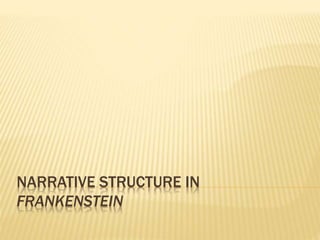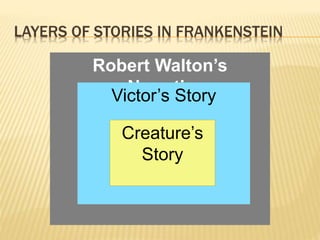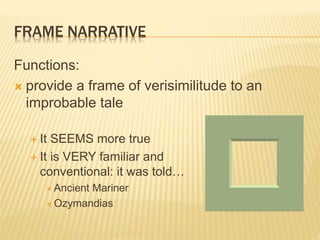Narrative framing devices in Frankenstein
- 2. FRANKENSTEIN ’āÆ Frankenstein opens with letters from an explorer, Robert Walton, to his sister. ’āÆ The Explorer is stuck on his ship in the ice of the North Pole.
- 3. LAYERS OF STORIES IN FRANKENSTEIN Robert WaltonŌĆÖs NarrativeVictorŌĆÖs Story CreatureŌĆÖs Story
- 4. FRAME NARRATIVE A fusion of two respected 18th century genres ’āÆ epistolary novel, a traditionally feminine genre ’āÆ explorerŌĆÖs journal, a traditionally masculine genre and an archetypal enlightenment genre
- 5. FRAME NARRATIVE Functions: ’āÆ provide a frame of verisimilitude to an improbable tale ’āē It SEEMS more true ’āē It is VERY familiar and conventional: it was toldŌĆ” ’āÉ Ancient Mariner ’āÉ Ozymandias
- 6. EPISTOLARY NOVEL ’āÆ A Novel written as a series of documents ’āē Letters ’āē Diary entries ’āē Newspaper clippings ’āē Blogs ’āē Emails
- 7. EPISTOLARY NOVEL CONVENTIONS ’āÆ Reveal inner life: individual psychological struggles ’āÆ Growth to knowledge and virtue
- 8. IDEOLOGICAL FUNCTIONS ’āÆ Reassure readers of the capacity of individual to combat the temptations of evil and grow towards virtue
- 9. FRANKENSTEIN SUBVERTS THE EPISTOLARY NOVEL ’āÆ Male narrator ’āÆ No growth: fails to resists temptations; learns nothing
- 10. EXPLORERŌĆÖS JOURNAL CONVENTIONS ’āÆ Protagonist : heroic scientist-explorer ’āÆ Quest structure ŌĆō pursuit and achievement of a goal (c.f. the heroŌĆÖs journey) ’āÆ Encounters with strange lands, creatures and beings ’āÆ Increased understanding of the world and humanity
- 11. EXPLORERŌĆÖS JOURNAL Ideological functions ’āÆ celebrate the quest for knowledge and the power of reason ’āÆ celebrate human achievement - illustrate manŌĆÖs increasing mastery of his world (archetypal embodiment of enlightenment ideologies)
- 12. Frankenstein subverts the conventions and ideologies of the ExplorerŌĆÖs Journal genre ŌĆó Heroic protagonist exposed as flawed: narcissistic etc ŌĆó Quest ends in failure ŌĆō reveals human limitations, rather than celebrating achievements ŌĆó Protagonist learns nothing from experiences and encounters NB: GulliverŌĆÖs Travels
- 13. Further subverts the ExplorerŌĆÖs Journal by embedding within it a disreputable genre ŌĆō a gothic tale. Foregrounds the importance of the ExplorerŌĆÖs Journal genreŌĆÖs neglect of the: ’āÆ irrational ’āÆ inexplicable ’āÆ supernatural
- 14. VICTOR FRANKENSTEINŌĆÖS GOTHIC TALE Gothic conventions ’āÆ Emphasis on the irrational and fantastic ’āÆ Emphasis on emotion rather than reason Challenge to enlightenment values
- 15. ’āÆ Setting: relics of past corrupt society or wilds of nature ’āÆ Protagonist: innocent, often virginal, victim ’āÆ Villain: supernatural figure or authoritarian patriarchal figure representative of past, corrupt regime ’āÆ Narrative structure: triumph over the monstrous
- 16. IDEOLOGICAL FUNCTIONS ’āÆ Acknowledge the existence of the monstrous ’āÆ Reassure readers that the monstrous can be defeated or controlled
- 17. FRANKENSTEIN SUBVERTS THESE CONVENTIONS AND IDEOLOGIES ’āÆ Setting: locates monstrosity in everyday world: bourgeois domestic sphere ’āÆ Protagonist: is victim and villain/monster ’āÆ Ironically, victim of own villainy
- 18. ’āÆ The monstrous a product of human action: external diabolical agency replaced by internal human agency ’āÆ The evil patriarch is an archetypal enlightenment bourgeois figure ’āÆ Villain is victim and hero
- 19. ’āÆ Blurs boundaries between victim, villain and hero and human/non-human ’āÆ The monstrous not defeated or controlled


















